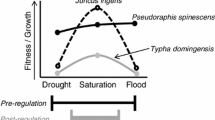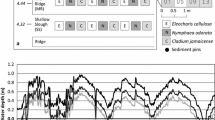Abstract
We evaluated growth and physiology of three wetland graminoids (Distichlis spicata, Leymus triticoides, and Juncus arcticus) as affected by surface and subsurface water. These species are common in western USA and were collected from two areas: Bishop, California and Burns, Oregon. Our hypotheses were: 1) the use of surface water by plants is higher than the use of subsurface water and 2) there are population differences in the response of the species to available water. The species of study were grown in two-layer pots with soil water content in the upper and lower layers independently controlled. The first hypothesis was partially supported by our results, but variability existed among species. However, when all species had equal access to both surface soil water and subsurface water plants tended to preferentially use surface water. We also found that J. arcticus can display reverse hydraulic lift when growing with no subsurface water. The second hypothesis was clearly supported by results. Although the mechanism is not clear, it is possible that an area with periodic and predictable shallow groundwater underlying a dry or saline soil layer, such as the California site, might favor plant populations with high proficiency in water uptake by deeper roots.





Similar content being viewed by others
References
Abdallah MAB, Mata-Gonzalez R, Martin DW, Trejo-Calzada R, Noller JS (2017) Effects of surface and subsurface water application on nitrogen and sodium relations of desert graminoids of different geographic origin. Arid Land Research and Management 31:1–13
Adiku SGK, Rose CW, Braddock RD, Ozier-Lafontaine H (2000) On the simulation of root water extraction: examination of a minimum energy hypothesis. Soil Science 165:226–236
Alpert P (1990) Water sharing among ramets in a desert population of Distichlis spicata (Poaceae). American Journal of Botany 77:1648–1651
Caudle KL, Maricle BR (2015) Physiological and ecological effects of spilled motor oil on inland salt marsh communities: A mesocosm study. Wetlands 35:501–507
Chambers J, Linnerooth A (2001) Restoring riparian meadows currently dominated by Artemisia using alternative state concepts - the establishment component. Applied Vegetation Science 4:157–166
Dahlgren RA, Richards JH, Yu Z (1997) Soil and groundwater chemistry and vegetation distribution in a desert playa, Owens Lake, California. Arid Soil Res. Rehabilitation 11:221–244
Devitt DA, Fenstermaker LF, Young MH, Conrad B, Baghzouz M, Bird B (2011) Evapotranspiration of mixed shrub communities in phreatophytic zones of the Great Basin region of Nevada (USA). Ecohydrology 4:807–822
Doescher PS, Svejcar TJ, Jaindl RG (1997) Gas exchange of Idaho fescue in response to defoliation and grazing history. Journal of Range Management 50:285–289
Evans TL, Mata-Gonzalez R, Martin DW, McClendon T, Noller JS (2013) Growth, Water productivity, and biomass allocation of Great Basin plants as affected by summer watering. Ecohydrology 6:713–721
Ferrante D, Oliva GE, Fernandez RJ (2014) Soil water dynamics, root systems, and plant responses in a semiarid grassland of Southern Patagonia. Journal of Arid Environments 104:52–58
Goedhart CM, Pataki DE, Billings SA (2010) Seasonal variations in plant nitrogen relations and photosynthesis along a grassland to shrubland gradients in Owens Valley, California. Plant and Soil 327:213–223
Heitman JL, Xiao X, Horton R, Sauer TJ (2008) Sensible heat measurements indicating depth and magnitude of subsurface soil water evaporation. Water Resources Research 44:W00D05
Hoover DL, Duniway MC, Belnap J (2017) Testing the apparent resistance of three dominant plants to chronic drought on the Colorado Plateau. Journal of Ecology 105:152–162
Jackson RB, Canadell J, Ehleringer JR, Mooney HA, Sala OE, Schulze ED (1996) A global analysis of root distributions for terrestrial biomes. Oecologia 108:389–411
Kemp PR, Cunningham GL (1981) Light, temperature and salinity effects on growth, leaf anatomy and photosynthesis of Distichlis spicata (L.) Greene. American Journal of Botany 68:507–516
Kray JA, Cooper DJ, Sanderson JS (2012) Groundwater use by native plants in response to changes in precipitation in an intermountain basin. Journal of Arid Environments 83:25–34
Kubiske ME, Abrams MD (1992) Photosynthesis, water relations, and leaf morphology of xeric versus mesic Quercus rubra ecotypes in central Pennsylvania in relation to moisture stress. Canadian Journal of Forest Research 22:1402–1407
Leffler AJ, Ivans CY, Ryel RJ, Caldwell MM (2004) Gas exchange and growth responses of the desert shrubs Artemisia tridentata and Chrysothamnus nauseosus to shallow- vs. deep-soil water in a glasshouse experiment. Environmental and Experimental Botany 51:9–19
Manning ME, Swanson SR, Svejcar T, Trent J (1989) Rooting characteristics of four intermountain meadow community types. Journal of Range Management 42:309–312
Mata-Gonzalez R, Sosebee RE, Wan C (2002) Physiological impacts of biosolids application in desert grasses. Environmental and Experimental Botany 48:139–148
Mata-González R, McLendon T, Martin DW, Trlica MJ, Pearce RA (2012a) Vegetation as affected by groundwater depth and microtopography in a shallow aquifer area of the Great Basin. Ecohydrology 5:54–63
Mata-González R, Martin DW, McLendon T, Trlica MJ, Pearce RA (2012b) Invasive plants and plant diversity as affected by groundwater depth and microtopography in the Great Basin. Ecohydrology 5:648–655
Mata-González R, Evans TL, Martin DW, McLendon T, Noller JS, Wan C, Sosebee RE (2014) Patterns of water use by great basin plant species under summer watering. Arid Land Res Manag 28:428–446
McLendon T, Hubbard PJ, Martin DW (2008) Partitioning the use of precipitation- and groundwater-derived moisture by vegetation in an arid ecosystem in California. Journal of Arid Environments 72:986–1001
Meixner T, Manning AH, Stonestrom DA, Allen DM, Ajami H, Blasch KW, Brookfield AE, Castro CL, Clark JF, Gochis DJ, Flint AL, Neff KL, Niraula R, Rodell M, Scanlon BR, Singha K, Walvoord MA (2016) Implications of projected climate change for groundwater recharge in the western United States. Journal of Hydrology 534:124–138
Miller RF, Branson FB, McQueen IS, Snyder CT (1982) Water relations in soils as related to plant communities in Ruby Valley, Nevada. Journal of Range Management 35:462–468
Mounsif M, Wan C, Sosebee RE (2002) Effects of top-soil drying on saltcedar photosynthesis and stomatal conductance. Journal of Range Management 55:88–93
Natural Resources Conservation Service (2002) Soil Survey of Benton-Owens Valley Area, California Parts of Inyo and Mono Counties. U. S. Department of Agriculture-Natural Resources Conservation Service, Washington, DC
Naumburg E, Mata-Gonzalez R, Hunter RG, McLendon T, Martin DW (2005) Phreatophytic vegetation and groundwater fluctuations: A review of current research and application of ecosystem response modeling with an emphasis on Great Basin Vegetation. Environmental Management 35:726–740
Nichols WD (1994) Groundwater discharge by phreatophyte shrubs in the Great Basin as related to depth to groundwater. Water Resources Research 30:3265–3274
Pataki DE, Billings SA, Naumburg E, Goedhart CM (2008) Water sources and nitrogen relations of grasses and shrubs in phreatophytic communities of the Great Basin Desert. Journal of Arid Environments 72:1581–1593
Ryel RJ, Ivans CY, Peek MS, Leffler AJ (2008) Functional differences in soil water pools: A new perspective on plant water use in water-limited ecosystems. Progress in Botany 69:397–422
Ryel RJ, Leffler AJ, Ivans CY, Peek MS, Caldwell MM (2010) Functional differences in water use patterns of contrasting life forms in Great Basin steppelands. Vadose Zone Journal 9:548–560
Sala A, Nowak RS (1997) Ecophysiological responses of three riparian graminoids to changes in the soil water table. International Journal of Plant Sciences 158:835–843
Sardans J, Peñuelas J (2014) Hydraulic redistribution by plants and nutrient stoichiometry: shifts under global change. Ecohydrology 7:1–20
Schulze ED, Mooney HA, Sala OE, Jobbagy E, Buchmann N, Bauer G, Canadell J, Jackson RB, Loreti J, Oesterheld M, Ehleringer JR (1996) Rooting depth, water availability, and vegetation cover along an aridity gradient in Patagonia. Oecologia 108:503–511
Schulze ED, Caldwell MM, Canadell J, Mooney HA, Jackson RB, Parson D, Scholes R, Sala OE, Trimborn P (1998) Downward flux of water through roots (ie . inverse hydraulic lift) in dry Kalahari sands. Oecologia 115:460–462
Smoliak S, Ditterline RL, Scheetz JD, Holzworth LK, Sims JR, Wiesner LE, Baldridge DE, Tibke GL (1990) Montana Interagency Plant Materials Handbook. Montana State University. Extension Service Bull. 69. Bozeman, Montana
SPSS Inc (2000) SYSTAT 10, Statistics, I. SPSS Inc., Chicago
Svejcar T, Riegel GM (1998) Spatial pattern of gas exchange for montane moist meadow species. Journal of Vegetation Science 9:84–94
Topp GC, Davis JL, Annan AP (1980) Electromagnetic determination of soil water content: Measurements in coaxial transmission lines. Water Resources Research 16:574–582
Wan C, Sosebee RE, McMichael BL (1993) Growth, photosynthesis, and stomatal conductance in Gutierrezia sarothrae associated with hydraulic conductance and soil water extraction by deep roots. International Journal of Plant Sciences 154:144–151
Wan C, Sosebee RE, McMichael BL (1994) Hydraulic properties of shallow vs. deep lateral roots in a semiarid shrub, Gutierrezia sarothrae. The American Midland Naturalist 131:120–127
Wan C, Sosebee RE, McMichael BL (1995) Water acquisition and rooting characteristics in northern and southern populations of Gutierrezia sarothrae. Environmental and Experimental Botany 35:1–7
Wan C, Xu W, Sosebee RE, Machado S, Archer T (2000) Hydraulic lift in drought-tolerant and -susceptible maize hybrids. Plant and Soil 219:117–126
Xiao X, Horton R, Sauer T, Heitman JL, Ren T (2011) Cumulative soil water evaporation as a function of depth and time. Vadose Zone Journal 10:1016–1022
Xu H, Li Y (2006) Water-use strategy of three central Asian desert shrubs and their responses to rain pulse events. Plant and Soil 285:5–17
Xu H, Li Y, Xu GQ, Zou T (2007) Ecophysiological response and morphological adjustment of two Central Asian desert shrubs towards variation in summer precipitation. Plant, Cell & Environment 30:399–409
Zhang X, Wu N, Li C (2005) Physiological and growth responses of Populus davidiana ecotypes to different soil water contents. Journal of Arid Environments 60:567–579
Acknowledgements
We are indebted to Dr. Tony Svejcar (USDA-ARS) and Mr. Chris Allen (LADWP) for providing information and facilitating the sampling of plant species in eastern Oregon and Bishop, CA, respectively. This research was funded by Oregon State University.
Author information
Authors and Affiliations
Corresponding author
Rights and permissions
About this article
Cite this article
Abdallah, M.A.B., Mata-González, R., Martin, D.W. et al. Consequences of Surface and Subsurface Water Use on Wetland Graminoids of Different Geographic Origin. Wetlands 38, 121–131 (2018). https://doi.org/10.1007/s13157-017-0961-x
Received:
Accepted:
Published:
Issue Date:
DOI: https://doi.org/10.1007/s13157-017-0961-x




